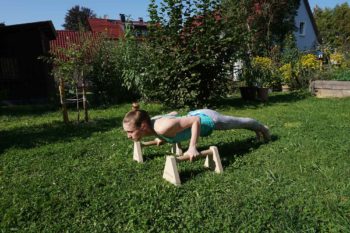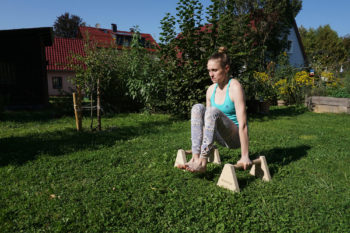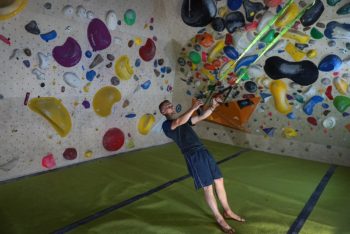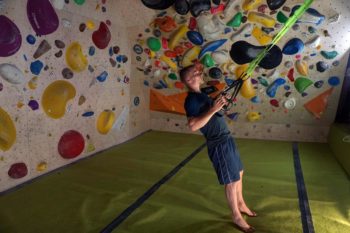You don’t need much for training at home. The benefits, however, are great: You can build up strength, prevent overstrain, or train special moves – all without leaving home.
If you are considering setting up a small home gym at home, you should consider the following aspects:
- Space: You won’t need much space, just a few square meters are enough for a few floor exercises.
- Conditions: A free doorframe can be useful, for example, to attach a fingerboard or a pull-up bar.
- Regularity: The exercises shown below do not require much time, but should be done regularly.
- Equipment: The four exercise machines Parallettes, Fingerboard/fingerboard, Sling Trainer and Theraband cover by far the largest part of additional training at home.
Parallettes

Parallettes are basically two handles with a wider supporting surface. They could also be called mini-bars because that is where they originated. This training device has been made to lean on it, i.e. to do various exercises from push-ups to handstands on it.
When climbing or bouldering, it is mainly the pulling muscles that are required – this can have a negative effect on the shoulder in particular, as it is mainly subjected to one-sided strain and possibly incorrect movement patterns are established. True to the motto: the working muscles can only be as fit as the antagonist, you have found the right training equipment here.
Exercises with the parallettes
The simplest exercise is the classic push-ups, also called push-ups.
- Stand parallel pieces shoulder-width apart on the floor and support yourself with outstretched arms.
- Build body tension up to the tips of your toes and slowly lower your body towards the floor.
- Try to keep your elbows close to your body and push yourself back into the starting position after you have reached the lowest position.
This exercise is best suited for beginners who first want to build up strength. To ease the exercise, it is advisable to place your legs on the floor at an angle instead of your outstretched feet. For the beginning, choose the intensity so that between 12 and 15 repetitions are possible. Of these 3-4 sets can be completed.
Another exercise for advanced students is the so-called swinging through. This exercise is aimed more at the rotator cuff of the shoulder and is a little more complex to perform because the timing of the muscles has to be right. To do this, lean into the parallel mini-bars, facing forward and swing through the parallel bars with your legs tightened.
- The feet are placed on the floor in front of the parallels, the upper body is in an upright position, the shoulder blades are centred backwards. The pelvis is positioned in front of the upper body.
- Now the legs are pulled up and at the same time bent again a little.
- By supporting and using the shoulder, the legs are pulled back through the parallels into the starting position.
As this exercise is very coordinative and demanding, it makes sense to start in a rested state. For the beginning it is advisable to do 1 – 3 repetitions with a sufficient break between sets. It is important that the exercise is performed cleanly.
Slingtrainer
The origin of the slingtrainer can be traced back to the US Navy Seals, who developed the first full-body exercises due to a lack of training possibilities with belt straps. The Suspension Training (also: TRX Training) was developed by Randy Hetrick, a US elite soldier. During his stationing in South East Asia he started to experiment with a Jiu-Jitsu belt and parachute straps and developed his own strength training. Meanwhile there are more than 300 different TRX exercises, which on the one hand offer a great variety and on the other hand can be performed in a small space.
Exercises with the slingtrainer
You can train almost every muscle group of your body on this training device. If you have a little trouble putting it on, the sling is an excellent way to work under stress. Both feet are on the ground and both hands grasp the sling’s straps.
- Lean the upper body back until a suitable angle is found. The steeper the angle, the greater the load.
- The upper body and the stretched legs form a line. The shoulder blades are centred. In the starting position both arms are stretched.
- Now both arms are flexed, like a chin-up, while the body remains in line. The position is held for a short time, then the arms are stretched again slowly to the starting position.
This exercise can also be performed with one arm, depending on the training condition. For the beginning, choose the intensity so that between 12 and 15 repetitions are possible. Of these 3-4 ought to be completed.
The climbing or fingerboard

Finger and hand trainers are available in various designs: as kneading rings, as kneading balls, with spring resistance, as plasticine, or as rollerballs. Apart from strength training, they are particularly useful for warming up before climbing (so that fingers and muscles are warmed up a bit before starting the first route or the first bouldering) and for regeneration after climbing. In order to protect the skin on the fingers and also because of the aesthetics, I recommend a wooden fingerboard as training equipment. Door frames are the best place to hang it up.
Exercises with fingerboards
In any case, care must be taken with the fingerboard. For beginners, it is recommended to train only on the big ledges for the time being. When climbing, a distinction is made between different finger positions.
- Semi-fixed: The fingers are bent about 90 degrees, this position is optimal for the holding training because you can achieve a great training stimulus on the finger flexion musculature.
- Hanging: The fingers are stretched out long at the handle. Sloper for example is usually held in this position.
(Also “full up”, with fingers at an acute angle and thumb over-index and middle finger, is a position – but we do not recommend it for this exercise!)
In the beginning, it is best to choose a bar from which you can hang for about 15 seconds without problems. Hang from this bar for about four times for 15 seconds, with a break of about one minute in between. When the fingers have become accustomed to this load, the handle size can be reduced.
Therabands
The Fitness or Thera-band is a very versatile piece of training equipment that can be used both to increase strength and for balancing training. The coloured bands are available in many different strengths (from very elastic to less elastic). You can easily integrate the training with the fitness bands into your training at home, as the bands do not cost a lot of money and you hardly need any space for training.





